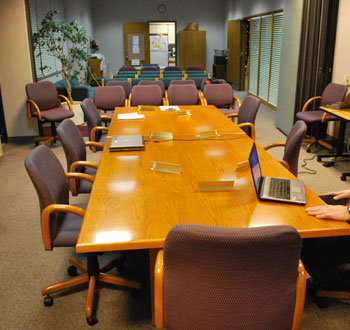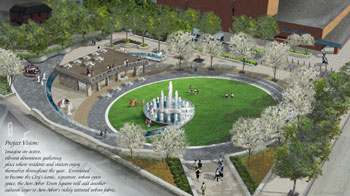Ann Arbor Transportation Authority board meeting (Dec. 16, 2009): At its regular meeting Wednesday night, the AATA board gave authorization to staff to solicit bids for the demolition, design and construction of a replacement for the Blake Transit Center, located in downtown Ann Arbor on Fourth Avenue.

At its headquarters on South Industrial Avenue, the AATA board tried out a makeshift venue for its Wednesday board meeting, because it offered an additional 12 seats for audience members, compared to the actual boardroom. Conceptual plans for the new Blake Transit transit center downtown include a boardroom. (Photos by the writer.)
The conceptual design calls for the new center to be constructed on the same footprint as the old center, with flexibility to expand, if abutting property were to become available.
The hope for flexibility on the Blake Transit Center design had also surfaced earlier in the day, at the Downtown Development Authority‘s transportation committee meeting. There, the concept of Fourth Avenue as a transit corridor had been floated by DDA executive director Susan Pollay.
In other business, the board kept the discussion going on the question of how to proceed in expanding its service to include more of Washtenaw County. But they did not consider any resolutions related to formation of a new, expanded public transit authority. As part of the effort to expand, a general board consensus emerged that the public needed to be educated about what public transit is, and how the AATA worked.
Related to the need to educate the public about what the AATA does was the treasurer’s report, submitted by Ted Annis, which recommended greater financial transparency through posting various financial data on the AATA website. The specific suggestion to post employee salaries was not embraced by all on the board, but the suggestions were remanded to the performance monitoring and external relations committee (PMER).
And a response by staff to the November treasurer’s report highlighted a potential point of contention in estimating revenues available for funding an expanded service. Specifically, how much revenue could be expected from fares in an expanded service? [Full Story]









